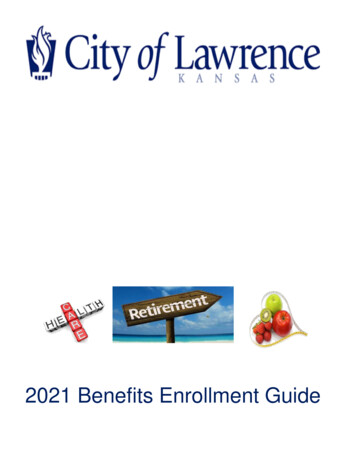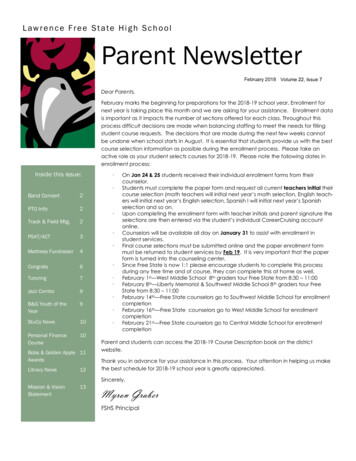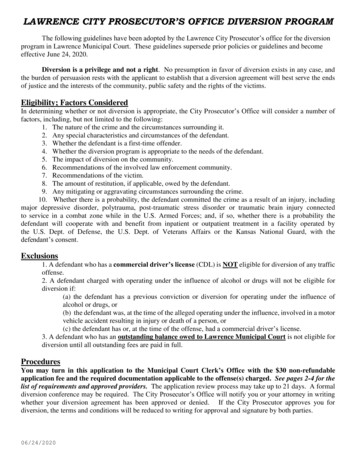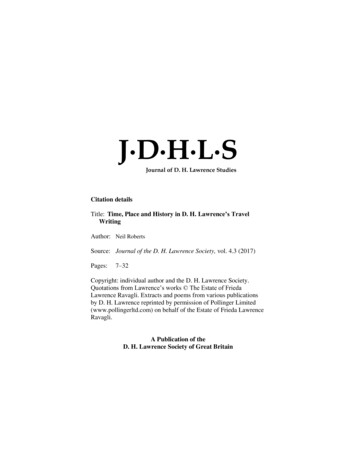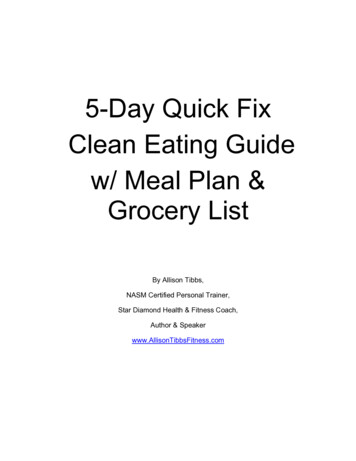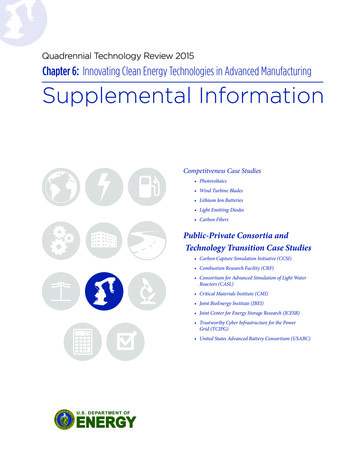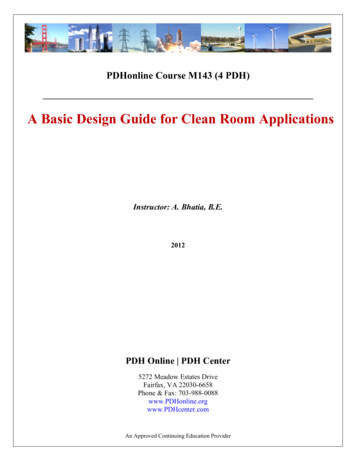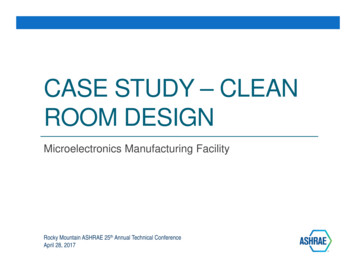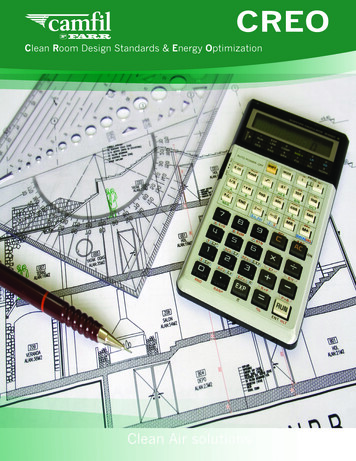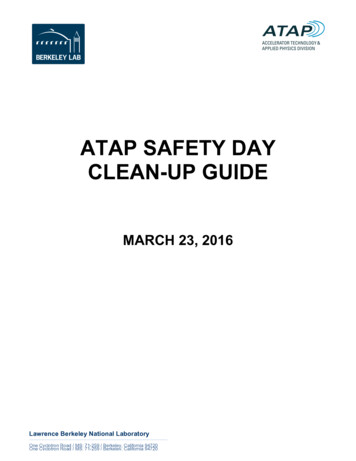
Transcription
ATAP SAFETY DAYCLEAN-UP GUIDEMARCH 23, 2016Lawrence Berkeley National LaboratoryOne Cyclotron Road / MS: 71-259 / Berkeley, California 94720One Cyclotron Road / MS: 71-259 / Berkeley, California 94720USA
IntroductionThe purpose of this Guide is to provide some basic information about how to participate in the ATAPSafety Day clean-up, while protecting your own safety and maintaining compliance with requirements.Table of ContentsSectionGeneral Clean-up SafetyClean-Up ChecklistWho to Call for further informationAerosol CansAsbestosBatteriesBerylliumCapacitorsChemicals (see Hazardous Waste)Compostable MaterialsComputers (see Electrical and Electronic Equipment)CryogensDrugsElectrical & Electronic Equipment (including Computers)Empty ContainersEpoxiesGas CylindersGlass (including Light Bulbs, Fluorescent Tubes, Cathode Ray Tubes)Hazardous CBsProperty (with LBNL property inventory sticker)Radioactive MaterialsRecyclable MaterialsSalvage 02020202122222424252526272
General Clean-up SafetyYour safety comes first: Follow supervisors’ instructions. Don’t attempt anything you are not trained to do. When in doubt, ask questions and get help. If it can’t be done safely today, identify action items.Protect yourself from hazards while cleaning:LiftingDon’t attempt to lift items that are too heavy for you to move safely. Get help.Don’t walk under cranes in use. Watch out for forklifts in motion.Eye ProtectionWear safety glasses in shops and labs.Foot ProtectionWhen heavy objects are being moved, wear safety shoes or stand clear.Hand ProtectionDon’t put your hands where you can’t see them.Wear gloves for handling sharp or hazardous materials.Dust/MoldIf too dusty, identify need for custodial clean-up and submit Work Request.Hazardous MaterialsDon’t handle materials you are not trained to handle. Get help.3
Clean-up ChecklistLocation: Person in Charge of Clean-upGeneral Safety Emergency information placards at entry doors are up to date. Safety glasses (or laser eyewear) are available at shop/lab entrances. Aisles, stairwells, and entry/exit areas are clear to allow egress in an emergency. Access to emergency eyewash/showers, electrical panels, and fire extinguishers is clear. “Drop, hold and cover” spaces are clear. Lab/shop benches and desks are neat, with adequate clear working space. Food areas are clean. Removal of Unneeded Materials and Equipment Recyclable materials (metals, paper, etc.) moved to recycling bins. Excess equipment moved to staging areas. Trash placed in bins. Electrical Equipment Inspected/Labeled Unneeded equipment has been taken out of service. Equipment with obvious safety hazards has been identified and taken out of service. Action taken to initiate repair of needed Failed or Conditionally Approved equipment. Seismic Inspection Completed Items that need anchoring (anything taller than 4 feet) have been identified. Heavy overhead items have been moved or restrained. Sharps Sharps needed for future use are stored with blades covered. Unneeded sharps have been disposed in sharps containers. Chemicals Primary (original from manufacturer) chemical containers have CMS Barcodes. Liquid chemicals are in containment trays. Secondary containers (squeeze bottles) are labeled with contents and hazard. Unwanted chemicals have been discussed with SAA Manager. Gas Cylinders and Cryogens Cylinders/dewars are appropriately restrained. Cylinders and dewars are labeled with contents and hazard. Unwanted cylinders/dewars have been reported to the Division Safety Coordinator.Management Sign-Off Date4
Who to call for further informationATAP ManagementATAP Division Director -- Wim Leemans -- 486-7788Deputy for Operations -- Asmita Patel -- 486-7021Deputy for Science and Technology -- Soren Prestemon -- 510-219-7789Program HeadsALS Accelerator Physics -- David Robin -- 486-6028BELLA Center -- Wim Leemans -- 486-7788Center for Bean Physics -- John Byrd -- 486-6329Fusion Science and Ion Beam Technology -- Thomas Schenkel -- 486-6674Superconducting Magnets -- Steve Gourlay -- 486-7156Safety CoordinatorsATAP -- Pat Thomas -- 486-6098ALS Accelerator Physics -- Tom Scarvie -- 486-7697BELLA Center -- Csaba Toth -- 486-5338Center for Bean Physics -- Greg Penn -- 486-4222Fusion Science and Ion Beam Technology -- Bernhard Ludewigt -- 486-7733Superconducting Magnets -- GianLuca Sabbi -- 495-2250EHS SupportEHS Liaison -- Herb Toor -- 486-5918Health and Safety Representative -- Julie Zhu -- 486-6871 or 510-309-4886Hazardous Waste Generator Assistant -- Deborah Price -- 486-5182 or 510-859-6227Building ManagersALS (Bldg. 6 & 15) -- Jeff Troutman -- 486-7358Bldg. 46 -- Mike Kritscher -- 486-8647Bldg. 47 -- Ian Pong -- 486-7866Bldg. 50A -- Tom Gallant -- 486-7022Bldg. 53 -- Andre Anders -- 486-674558 Complex -- Tom Lipton -- 486-763471 Complex -- Pat Thomas -- 486-609877 Complex -- Ted Keffeler -- 486-5907Bldg. 88 -- Mike Johnson -- 486-4389Property/Archives and RecordsATAP Property Representative/Records Liaison Officer -- Martha Condon -- 486-7135FacilitiesWork Request Center -- 486-6274 or https://workrequest.lbl.gov/jsp/workreq mainpage.jsp5
For matrixed personnel:ALS SafetyScott Taylor -- 486-4545 or 510-0220-5009Tennessee Gock -- 486-5013Doug Taube -- 486-4806Engineering Division SafetyMarshall Granados -- 486-7915 or 510-470-0450MSD Safety (for Bldg. 53)Mike Wisherop -- 486-74076
Aerosol CansWaste aerosol cans containing products most commonly used in ATAP shops, such as paints,degreasers, lubricants, penetrants, glass cleaners, etc. are managed as Universal Waste. Note thataerosol cans with particularly hazardous substances, such as pesticides, herbicides, or catalysts must bemanaged as hazardous waste.There is a collection container for aerosol cans in 58A-0006. If collection containers are needed in otherareas, contact Deborah Price at 486-5182 or 510-859-6227.AsbestosIf you encounter materials that may contain asbestos, contact EHS Subject Matter Expert Rob Connellyat 486-4028 and ATAP Generator Assistant Deborah Price at 486-5182 or 510-859-6227 for assistance.Handling asbestos requires special training, PPE, procedures, and work authorization.· Examples of Materials Manufactured with Asbestos1. Cement/asbestos panels and pipes (transite)2. High-temperature gaskets3. Pipe insulation (block, corrugated aircell, etc.)4. Mastic for vinyl flooring5. Vinyl floor tiles and sheet vinyl flooring6. Wallboard (Sheetrock)7. Electric wiring insulation8. Taping or joint compounds9. Spray-applied fireproofing and insulation10. Roofing felt/shingles/flashing11. Automotive brake linings and pads12. Ceiling tiles13. Fire-resistant gloves, clothing14. HVAC duct insulation and tape15. Linoleum and other resilient flooring16. Paint17. Fire doors18. Window putty19. Plaster/stucco20. Elevator/crane brake shoes7
Asbestos (continued)1. Friable ACM Containing 1% or Greater Asbestos (RACM)1. All RACM waste must be handled as hazardous waste. RACM will be thoroughlywetted before packaging, then packaged to prevent dispersion and to facilitate handling.2. The Waste Management Group at ext. 5867 or 5877 is responsible for determining thestorage and labeling requirements, selecting the disposal site, and manifesting andmaintaining disposal records. It will also assist in determining how best to package thewaste for disposal and arranging site pickup.3. Packaging1. Labels: All containers of RACM must bear the asbestos warning label and the"Hazardous Waste" label.2. Bags: Asbestos waste must be sealed inside two layers of 6-mil-thick plastic bagsafter thorough wetting. The excess air in the bag must be removed by a HEPAvacuum. The outer bag must be labeled as shown in the example below.4. Drums: Wetted asbestos waste can be contained in properly labeled Department ofTransportation (DOT) spec. 17H 55-gallon steel drums equipped with polyethylene drumliner bags.2. Nonfriable ACM (transite, floor tile, etc.), Contact the Waste Management Group for assistancewith labeling, storage, and disposal requirements. Labels may not be necessary if nonfriabilitycan be demonstrated.Asbestos label example: Appropriate wording for labeling friable materials containing 1.0% asbestosby weight, or greater. This label is also appropriate for containers (including waste containers) thatcontain 1.0% or greater friable asbestos by weight. Waste containers holding RACM and asbestoscontaminated materials (such as protective equipment and clothing) must also include a label with thegenerator name and location, and a hazardous-waste label.DANGERASBESTOSCancer and Lung Disease HazardAuthorized Personnel OnlyRespirators and Protective Clothing Are Required in This AreaSee also Hazardous Waste.8
BatteriesWaste Management provides green (or sometimes white) collection buckets for used nickel-cadmium;nonspillable, nonleaking lead acid; and alkaline batteries. All 9-V batteries and batteries with terminalson the same side must have the leads taped prior to placing in a battery bucket to prevent the possibilityof fire or sparking. Place your intact batteries in the collection bucket. The buckets are emptied once perquarter or as needed. For battery pick-up, contact Billy Johnson at 486-7674. The bucket locations atATAP are:ALS Bldg. 6 -- Bay 6, Bay13, 2101 mailroom, 2238 mailroomBldg. 46 – 1123 copy room, 125, 159, 172A, 172B, across from 275FBldg. 53 – 103Bldg. 58 – 001Bldg. 71-- 159C, 211, 230, 266Bldg. 71A -- 101cubicle by front doorBldg. 71B -- 287AAutomotive batteries (lead acid) can be sent to salvage as long as the caps are intact and the body is notdamaged or cracked.Hazardous batteries include batteries 100 and 1kW, or 100V. If you find hazardous batteries,contact a Qualified Electrical Worker. See Electrical and electronic equipment.For leaking lead-acid batteries, see hazardous waste.For further information on battery safety, see also Electrical Safety Manual Section 14.9
BerylliumBeryllium is primarily part of an alloy found in pieces of equipment such as chamber windows, targets,springs, foils, pins, connectors, and tools. If you find items you suspect may contain Beryllium andyou are not already trained and authorized to work with the materials, do not handle. ContactEHS Subject Matter Expert Eileen Lloyd at 495-6949 for assistance. Beryllium materials are disposedas hazardous waste. Beryllium waste requires special labeling and handling.CapacitorsCapacitors may contain stored electrical energy. To prevent electric shock, all uninstalled capacitorscapable of storing 5J or greater they should be stored in a short circuited condition (conductor betweenterminals). If you see any capacitors that are not shorted, do not handle -- contact a QualifiedElectrical Worker:ATAP Provisional Qualified Electrical WorkersAndre AndersTony GonsalvesQing JiChristopher PieronekMatrixed Engineering Division Provisional Qualified Electrical Workers include:Robert AlbrightKerri CampbellJim GalvinBill GhiorsoChip KozyArt MaganaGreg ManninoJoe RileyMarcos Turqueti (QEW2)Will Waldron (QEW2)Nathan YbarrolazaLarge capacitors may contain oil, and old ones may contain PCBs. See also PCBs.For further information on capacitor safety, see also Electrical Safety Manual Section 15.10
Compostable MaterialsWhat should go into the COMPOST bin? Food, food scraps Coffee grounds and filters, tea leaves, andtea bags Food-soiled paper: napkins, paper towels,paper plates, coffee cups, milk cartons Plastic that says “compostable” or has anumber 0 (The cafeteria’s to-go cups, clamshells,and utensils are compostable.)What should NOT go into the COMPOSTbin? Chip bags Food wrappers Aluminum foil Plastic (even if it has food residue) Glass (even if it has food residue) Metal (even if it has food residue)11
CryogensLBNL staff and affiliates must not: Dump liquid cryogens into any drain; nor Accumulate liquid cryogens in significant quantities in areas not appropriate for that purpose.NOTE: Even relatively small quantities can damage equipment or facilities and can crack floor tiles,damage water pipes, and damage electrical insulation on wiring. Also, consider the hazard presented bythe boil-off gas when any significant quantities of a cryogenic liquid are released.Contact EHS Cryogen Subject Matter Expert Scott Robinson at 486-7955 or 925-324-0222 and ATAPHazardous Waste Generator Assistant Deborah Price at 486-5182 or 510-859-6227 for assistance indetermining the best way to dispose of cryogenic liquids.DrugsThe disposal of over-the-counter drugs and pharmaceuticals at Berkeley Lab is strictly controlled. Forlegal drugs brought to the Lab for personal use, the owner of the drugs should take responsibility foreither using the products as intended or taking them home. If the owner cannot be determined, contactthe EHS Division Liaison EHS Liaison Herb Toor at 486-5918 or Health and Safety Representative -Julie Zhu at 486-6871 or 510-309-4886. Waste Management maintains a contract with a registereddisposal company.In the unlikely event that you encounter unauthorized controlled substances or illegal drugs, callProtective Services at 486-6999 immediately.12
Electrical and Electronic Equipment (including Computers)Electronic devices include telephones, cash registers, computers, computer peripherals, stereoequipment, videocassette players/recorders, tape players/recorders, compact disc players, recorders,calculators, microwave ovens – generally, anything with a printed circuit board.For nonfunctioning electronic devices:In general, if a nonfunctioning item has a printed circuit board, it is e-waste Apply a universal-waste label to the nonfunctioning item. Label the item as “Universal Waste —Electronic Device(s)” or “Universal Waste — CRTs” when applicable. If the item has a Berkeley Lab/DOE property-number sticker, fill out a Facilities Work Request;the Facilities Division will remove the item from your property record. If the nonfunctioning item does not have a DOE property number, contact the WasteManagement Group (ext. 4644 or ext. 6337).For functional and reusable electronic devices:If you have unwanted computers or peripherals, first contact ATAP Computer Support— Joe Chew at486-5734 or 612-9116 to determine whether there is a need for this equipment within ATAP.If the electronic device is fully functional and reusable but is not needed, it should be sent to Salvage.See Salvage Pick-up. If the device can be used in another ATAP work area, check to see whether it hasan LBNL AHJ electrical equipment inventory sticker. These stickers look similar to property bar codes,but are larger. If items with AHJ sticker on it is relocated or re-assigned to a new owner, the inventorywill need to be updated. Contact Ohmar Sowle at 486-4520 to report the new owner/locationinformation.Never leave electronics or universal waste outside without adequate containment or cover. Theseitems often contain lead or other hazardous materials that could contaminate water run-off.See also:Glass for monitors and cathode ray tubes.Property for items with property inventory stickers.13
Empty ContainersCertain empty containers that previously held hazardous materials are exempt from hazardous-wasteregulations and can be discarded as solid sanitary waste (trash) under the following conditions: The container must be 5 gallons in size. The container did not contain an extremely or acutely hazardous material. Without rinsing, the container contains no drainable or pourable liquid when held in anyorientation. Without rinsing, the container contains no removable solids other than a thin, uniform layer ofdried material or powder.If your container meets the criteria listed above, the container may be thrown in the trash, and thefollowing steps must be completed:1.The container must be deleted from the Chemical Management System, and the bar code mustbe removed from the container.2.The original label must be crossed out or marked with the word “EMPTY” to notify custodialstaff, recyclers, or sanitary-waste engineers that it no longer contains hazardous materials, andcan be discarded as solid sanitary waste.14
EpoxiesEpoxy materials come in two parts. In most instances, Part A is the resin, and Part B is the hardener.Once blended together, any excess, unused material is nonhazardous and can be disposed of in thesanitary trash.If there are unwanted, unused portions of the Part A and Part B materials remaining in the originalcontainers, these require management as hazardous wastes. If the Part A and Part B are in separatecontainers, bag them separately and manage each as hazardous wastes in your SAA. If they are in asingle unit, be sure to secure the stopper in place to prevent comingling of the resin and hardener. Placethe unit in a bag and manage it as hazardous waste.See also Hazardous Waste.15
Gas CylindersEmpty Gas Cylinder Return ProceduresTo coordinate return of non-routine gas cylinders, LBNL maintains a Smartsheet listing of cylinderspeople want to return. If you have cylinders you want to add to the list, contact Pat Thomas at 486-6098and provide the following information: requestor name, cylinder location, supplier, whether the cylinderin empty/full/don’t know, gas contents, and cylinder size. When there are enough requests for pick-upfrom the same vendor, EHS will help to arrange a consolidated pick-up.The following summarizes the different requirements (as of 2013) for returning empty and unwantedcompressed gas cylinders. Compressed gas cylinders should always be handled as if they were “full”and must be transported in compliance with applicable Department of Transportation (DOT) hazardousmaterials requirements. This includes proper labels and cylinder caps. Always clearly identify “empty”cylinders with an affixed “EMPTY”, “MT” or “RETURN” tag.ContactVendorAerisAir LiquideAir ProductsAircoAirgasLBNL- OwnedLindeSee contact information for MathesonGasShelley TaniguchiShelley-taniguchi@airliquide.com(800) 323-2212See contact information for AirgasSee contact information for AirgasCustomer Service(800) 336-4004Neil O’DonnellProgressive Industriesnodennell@progressivepii.com(773) 763-9565LBNL ProcurementLaura Sanderslsanders@lbl.gov(510) 486-4592Theresa BirkTheresa.birk@linde.com(908) 329-9779ProcedureSee procedure for Matheson GasAir Liquide does not make regular deliveries or pickups from LBNL. Call Customer Service to make specialarrangements. Identify the number of cylinders, types ofgases, and cylinder ID number engraved on the cylindercollar.See procedure for AirgasSee procedure for AirgasAirgas makes deliveries and pick-ups from LBNL, butthese can be infrequent. Call Customer Service ifcylinders are accumulating and need to be picked-up. Inaddition, gas cylinder returns can be requested throughthe Airgas EBuy website.Cylinders are identified with a “LBNL” stencil on thecylinder body. They normally have Airgas labelsaffixed. Procurement will make arrangements for pickup and scrapping.Complete and submit a Linde return form. Linde doesnot pick-up empties directly. They will send YellowFreight to pick-up. Yellow Freight only knows to go tothe B69 shipping dock, so call LBNL Transportation(X4388) and arrange to have the cylinders moved therefirst.16
Gas Cylinders (continued)MathesonPraxairScott Specialty GasScott-MarrinSpectra GasLouiseAratalarata@mathesongas.com(510) 793-2559 X109Monique OrtizCustomer ServiceMonique m ortiz@praxair.com(925) 431-2263Steve ScagliottiSteve scagliotti@praxair.com(925) 431-2297See contact information for Air LiquideLori Thomas- Saleslori@scottmarrin.com(951) 653-6780See contact information for LindeMatheson does not make regular deliveries or pick-upsto LBNL. Identify the number of cylinders, types ofgases, and cylinder ID number engraved on the cylinde
Center for Bean Physics -- John Byrd -- 486-6329 Fusion Science and Ion Beam Technology -- Thomas Schenkel -- 486-6674 Superconducting Magnets -- Steve Gourlay -- 486-7156 . Roofing felt/shin


